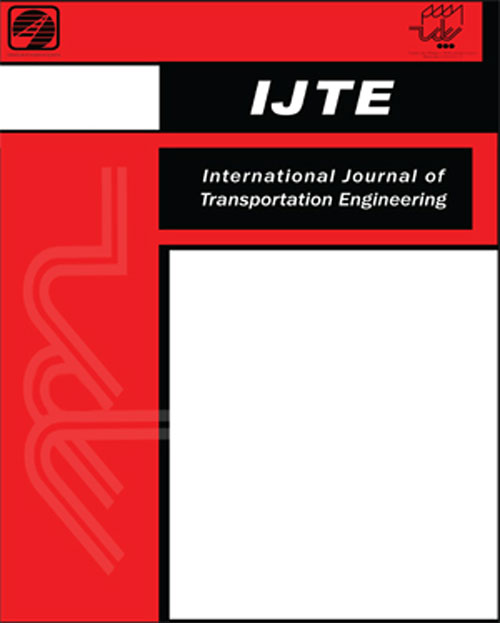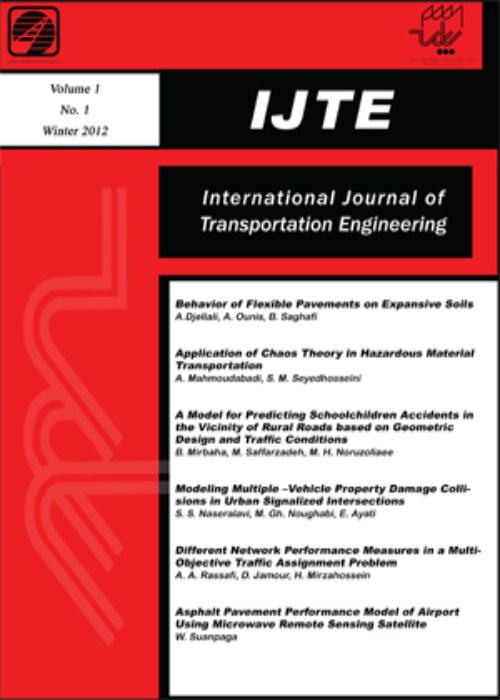فهرست مطالب

International Journal of Transportation Engineering
Volume:2 Issue: 1, Summer 2014
- تاریخ انتشار: 1393/08/28
- تعداد عناوین: 6
-
-
Pages 1-12Keeping the density of traffic flow and air pollution in an acceptable level and developing a good capacity for transit in the high priority areas of the city, is really a big deal in large and crowded cities. To address this problem, a new method of intersection signal optimization is presented in this paper. Based on network fundamental diagrams, an Internal–External Traffic Metering Strategy (IETMS) is developed for controlling density of traffic in high priority areas globally. Protecting the network from gridlock, optimizing the queue ratios in entrance arterials and utilizing the reserved capacity are the main objectives of the problem. The methods of mixed integer linear programming and quadratic programming are used for solving the problem. A traffic simulator software (VISSIM) has been used for simulation in which the coded program is developed in VISSIM-COM interface. Finally the model is applied in a part of urban network of Tehran, Iran. The results show that redistributing of traffic density in the whole network and protecting high density areas from gridlock can efficiently improve traffic flow measurement in high priority areas.Keywords: Signal control, traffic metering, fundamental diagrams
-
Pages 13-20Increasing number of air travellers in recent years and the emergence of multi-airport cities throughout the world has made the behaviour of travellers regarding the choice of the origin airport even more important. Analysis of this behaviour helps for a better future planning and development of competing airports as an important element of their demand prediction. In this paper, particular emphasis is stressed on the behaviour of resident and non-resident passengers in choosing between the origin airport through the empirical case study of the two airports of Tehran multi airport system, namely Imam Khomeini (IKIA) and Mehrabad International Airport (MIA) in Iran. The 24- hour and one-week survey was conducted in May 2011 and a total number of 2980 questionnaires were collected from the two airports. Binary Logit was used to model the origin airport choice of resident and non-resident travellers from the city of Tehran. Results show that the difference in the two groups is affected by “age”, “Income”, “Travel Destination”, “Trip Purpose” and “Marital Status”. Further model results show that variables “Public Access”, “Flight Frequency” and “Airport Tax” are more important for non-resident air travellers in choosing their origin airport.Keywords: Discrete choice, Binary Logit Models, multi, airport cities, stated preference, air passenger behaviour
-
Pages 31-46Finite element method in pavement analysis is a type of mechanistic analysis that has widely been used by road and transportation engineers these days. This method is used with related programs such as ABAQUS/CAE which is one of the powerful software on this task. Modeling in this software has been developed from 2D static models to 3D dynamic models which are closer to reality due to the more precise definition of material properties. A 3D model of a three layered pavement system has been studied in this paper. Viscoelastic behavior definition for asphalt concrete (AC) layer which is loaded by “Dual-wheel Tandem” and “Tridem” axles has been modeled in ABAQUS/CAE. These axles are moving with different velocities. Since the model is a flexible pavement, two important structural damages are “Fatigue Cracking” and “Rutting”. In order to calculate the allowable number of load repetition to prevent each of those distresses, the horizontal tensile strain under the hot mixed asphalt (HMA) layer and vertical compressive strain on top of the subgarde are needed. The concentration of this study is based on the responses of flexible pavement. Moreover, a comparison due to moving “Dual-wheel Tandem” and “Tridem” axles loading with different velocities is made. The parameters used for comparison are the allowable numbers of load repetition to prevent “Fatigue Cracking” and “Rutting”. Due to the comparison between two configurations of axles and their speed two conclusions have been made. Stresses reduce with increase in speed up to 100km/h under two axle configurations. Also, the allowable number of Tridem axle passages to prevent Fatigue Cracking and Rutting is higher under Dual-wheel Tandem configuration.Keywords: Axles comparison, moving load, finite element method, viscoelastic behavior, flexible pavement
-
Pages 47-66Increasing pressures caused by negative consequences of transportation and traffic problems in major cities, have resulted many attempts towards improvement of planning and management of transportation systems, according to sustainability objectives. In this paper, a comprehensive model is developed using a system dynamics approach to evaluate sustainable urban transportation. This model includes social, economical, environmental, and urban transportation variables. Then, the validation of the model according to actual data for years 1994 to 2009 of City of Mashhad are performed. The base year for simulation was 2009 and the horizon year was 2044. This stage is very important because all of the analyses and decisions made in the following steps will be based on the calibrated model. The sensitivity analysis of the parameters of the model showed that the selected variables have considerable influences on urban transportation sustainability. The proposed model can be used to find the optimal strategy for sustainable urban transportation.Keywords: Sustainability, urban transportation, system dynamics, simulation
-
Pages 67-80Earthquakes are among those natural hazards which may lead to disruption in the function of arterial traffic routes. Road networks are particularly vulnerable, due to their geographical dispersion, extensive functions and structural reliance on favourable geophysical conditions. Traffic functionality after a natural disaster and the repair/rehabilitation cost of roads are crucial considerations in planning the best priority recovery scenario. In the current paper, the primary focus is placed on the method for evaluating the costs of damage to the roadway network following an earthquake. Bridges, pavements, tunnels and base layers are assumed to be the main elements of a roadway structure. Through this approach, the level of damage can be specified for each component of the roadway. The repair/rehabilitation cost pattern can then be generated according to the level of damage, and the entire reconstruction costs can be calculated according to the total damaged surface area of each route. Finally, the total damage cost of roadways can be provided by considering the likely duration of the rehabilitation period, and determining the performance reduction in traffic flow caused by the damaged components. Secondly this paper demonstrates a method of measuring roadways’ functional performance. This method, based on path dividing and consideration of the attachment of sections leads to more precise feedback on roadways’ functionality. This is calculated by computing the width of sections in a route that remain undamaged and which retain the ability to sustain traffic flow. In this way, traffic flow and the linkage of sections can be determined as functions of road capacity.Keywords: Natural disasters, reconstruction cost, Traffic functionality
-
Pages 81-96The fatigue cracks are observed in asphalt surfaces much more than ruts. This paper deals with the influence of carbon nano-tube on the fatigue life of asphalt mixtures. These samples are made up of the slabs cut by the asphalt cutting saw. Fatigue beams contain 0, 0.3, 0.6, 0.9, 1.2, and 1.5 percent of Carbon Nano-tube. The fatigue experiment was conducted using a 4-point semi sinusoidal loading on a flexural beam for a constant strain (600 micro-strain) at 20oC. The end of these samples, fatigue life is assumed to be when 50% reduction in the initial rigidity happens. The results show that with an increase in the percentage of carbon nano-tube in the fatigue samples, the fatigue life of asphalt mixtures and the amount of cumulative dissipated energy increase noticeably, and the rate of damage propagation is reduced. Also rut depth, Fracture Energy density, Marshall Stability, Indirect Tensile strength have been improved excellently.Keywords: Fatigue life, carbon nano, tube, experiment of flexural beam, rate of damage propagation


